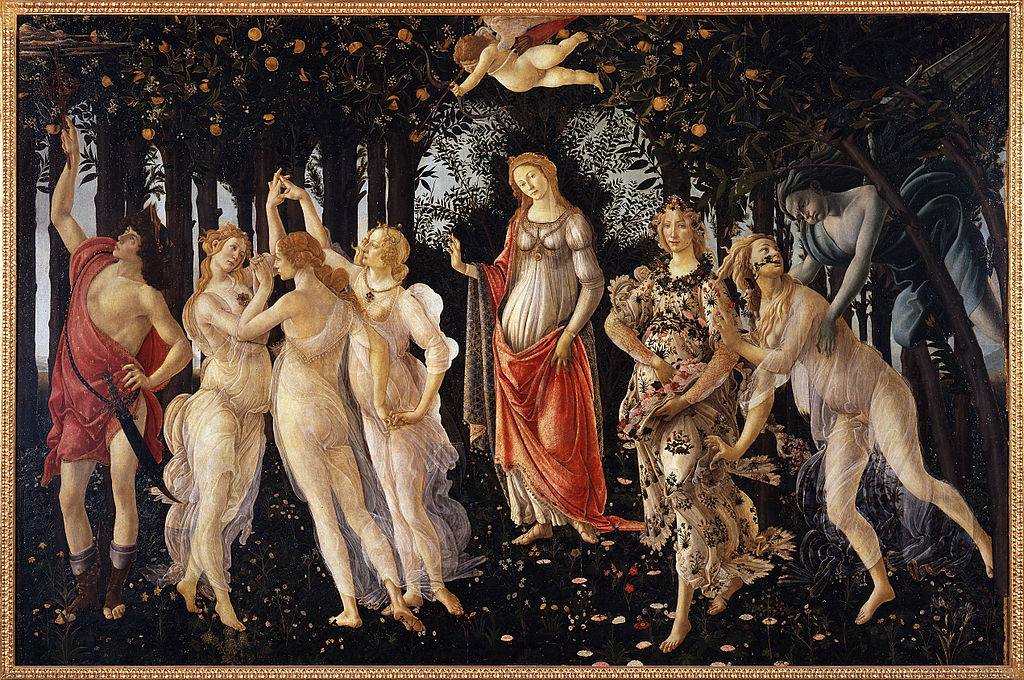Education
Cultural Revolution in the Renaissance?
The problem with this picture of the Renaissance is not that it has no truth to it—it certainly has some—but that it is perversely unbalanced.

It is a striking feature of our historical moment that vast numbers of cultural institutions, universities and professional associations have felt the need to express their horror at the sickening murder of George Floyd at the hands of a Minneapolis police officer on May 25th. Hundreds of such messages have shown up in my inbox since that day, from almost every institution that has my email address on its lists. (“Unsubscribe” is apparently one of those words that has a special meaning on the Internet, like “fact” and “free.”)
So it wasn’t really a surprise when the board governing the professional organization to which I feel closest, the Renaissance Society of America (RSA), decided to issue a “Statement in Support of Social Justice” last month, declaring its solidarity with the world-wide protests against “government-sanctioned brutality.” I wondered which organ of government had sanctioned the Floyd killing until I read further and met language blaming the incident on “a widespread and longstanding structure of anti-Black institutional racism that pervades American society and others around the globe,” a structure also characterized as “white supremacism.”
The board of directors then went on to instruct the RSA’s members how it thinks they should study and teach the Renaissance. We should recognize, they say, that the Renaissance as “remembered in the popular imagination” has a mostly positive, indeed dazzling image, but that we, who know better, should do our best, “whether we like it or not,” to “make room for the scholarship that explores early modernity in unflattering ways.” We should teach our students and the readers of our scholarship “how the technological, political, and financial creations of the early modern period have structured a Western European world view that has excluded or abused people of color.” The board reminds us that “the systems of higher education within which many of us work have long served as vehicles wherein those with advantage have accumulated more advantage.” We as a field have “a long way to go” in the task of denouncing the Renaissance’s “complicity” in elitist exclusions of “marginalized populations.” We should recognize our failure to focus sufficiently on “critical problems of enslavement, colonialism, and categories of blackness and whiteness.”
I don’t agree. To me the problem with the general public’s idea of the Renaissance is not that it is too positive, but that it has no distinct idea of the Renaissance at all. Does anyone think that the vast majority of Americans could accurately give even a rough set of dates for the beginning and end of the period? I remember some years ago, well-launched into the introductory lecture of my course on Renaissance Florence, being stopped by a student in the first row, vigorously waving her hand. “Please, professor, I’m trying to remember: which comes first, the Renaissance or the Enlightenment?” This from a Harvard undergraduate, supposedly the cream of America’s high school crop.
There is a reason for this ignorance. The Renaissance has been disappearing from high school classrooms for two generations now, a fact which RSA members have long bemoaned. The field of “Ren and Ref” that used to be standard in university history departments when I was a young historian has long been squeezed out between medieval and early modern history. That’s in the larger and better funded departments. In smaller ones the Renaissance is at best a one- or two-day stop in a survey course on premodern history or a tiny node in a global history of culture. In many art history departments the Renaissance is under a cloud because of its supposedly “elitist” character. In Italian departments it is hard enough to find someone who teaches Dante, let alone the less famous Trecento and Cinquecento authors, and most English departments abandoned their Shakespeare and Milton requirements decades ago.
Part of the reason for the gradual disappearance of the Renaissance from high schools and colleges, I am convinced, is the way the subject has often been taught in recent decades. Far too often it has been taught in exactly the unbalanced way that the RSA board urges us to teach it now. The economic life of the period, some colleagues stress, is one long tale of unjust exploitation. Its social world was rigidly stratified by wealth and ancestry; it marginalized and neglected the poor, the sick and the elderly. Its princes and oligarchs ruthlessly eliminated any who challenged their hold on power. The early Medici, admired for centuries as enlightened patrons of the arts, were in fact padrini, Mafia dons, who manipulated popular institutions to protect their wealth and influence. The art and humanistic literature of the Renaissance were the bought-and-paid-for property of elites whose only goal was to glorify themselves. The religion of Renaissance Christians can be best understood as an instrument of social control. What Jacob Burckhardt called “The Discovery of the World and of Man” was driven by the lust of imperialists to subject native peoples to European power. The lust for power was why women had no Renaissance, and why immigrants to Europe’s cities and the subject populations in its overseas colonies were hardly aware of its existence. The Renaissance itself was a self-serving myth, originating in the flattery of princes.
The problem with this picture of the Renaissance is not that it has no truth to it—it certainly has some—but that it is perversely unbalanced. It lacks any comparative context, probably because comparisons would reveal that the negative side of Renaissance society did not distinguish it markedly from other pre-modern societies. Fair comparisons might even reveal that Renaissance Europe in certain ways was more devoted to justice, more spiritually and artistically rich, and more charitable than many other premodern societies. For some reason many of my colleagues are ashamed to praise the positive achievements of the Renaissance, which, as it happens, are precisely those features that most set it apart from other historical periods. They fear, apparently, that to do so would make them sound naïve or, worse, somehow complicit in the evils of Western civilization.

In my view we Renaissance scholars have a great deal to admire and be grateful for in the period we study. We should not be reluctant to celebrate its achievements. I would go further and say that the writers, thinkers and artists of the Renaissance have messages for us today that we moderns still need to hear.
The RSA’s board of directors mentions only one Renaissance figure by name—Machiavelli—whom they excoriate for his “calculating ruminations on how to control populations [that] still serve as a ‘how to’ manual for leaders of all kinds.” I doubt whether many Machiavelli scholars would accept that as an adequate account of his influence. In my recent monograph Virtue Politics: Soulcraft and Statecraft in Renaissance Italy (Harvard, 2019) I was highly critical of Machiavelli for his malign influence on the Western political tradition, but there are many aspects of his thought that can and should be admired. Machiavelli was a bitter foe of abuses of power by self-proclaimed ottimati, for instance, and proposed new constitutional arrangements for Florence to protect those with less wealth and influence. Like other Florentine populists he despised and denounced scioperati, people who lived off the labors of others without contributing to society. Like other Renaissance republicans he believed that service to the state was a citizen’s highest calling. And, as Gabriele Pedullà has recently shown, Machiavelli’s doctrine of “conflictualism,” his defense of non-violent “tumults” as a legitimate feature of political life, became the fountainhead of the Western tradition of protest and helped secure the rights we have today to demonstrate peacefully against the government. Some of our students might find that interesting.
As I argue in my Virtue Politics, Machiavelli’s realism set him apart from the more idealistic mainstream of Renaissance political thinkers that flows from the humanistic teachings of Petrarch. The most characteristic and influential of these thinkers—Francesco Patrizi of Siena, whose political works rivaled Machiavelli’s in popularity during the 16th century—articulated many admirable political principles that deserve to have an audience today.
Like other humanists, Patrizi opposed what might be called “structural” political injustice, a political order built on hereditary prerogative and wealth. He called for the free cities and principalities of his day to be led by men and women of virtue, and argued, again like most humanists, that rulers who lacked virtue and wisdom lacked legitimacy. Civil society will inevitably have hierarchies, but they should be hierarchies that are morally justified by their care for society’s weakest members. Human societies are an organic whole, and we were born not for ourselves alone, but for our family, our friends, and our country (as the humanists delighted to quote from Plato).
Like almost all Renaissance humanists, Patrizi believed that the way to reform the political leadership of European societies was to educate them in the humanities. Studying poetry, history, eloquence, and moral philosophy would impart leadership skills as well as virtue and wisdom. The goodness and knowledge of Europe’s leaders would make them respected and increase their ability to rule their societies with the least possible coercion. This implied that in republics, where all citizens should take some part in government, all citizens should be educated. In his work on the government of free cities Patrizi was the first European thinker ever to call for all citizens to be literate (and in Latin!) as a condition of political participation. He argued that all cities should hire professors of humanities at public expense, so that those who could not afford higher education could have access to it free of charge.
Patrizi, like many other humanists, deplored the excessive power of the wealthy in the societies of his day, and called for extremes of wealth to be equalized through some form of redistribution. The wealthy should learn to control their greed and subordinate their acquisitive urges to the needs of their families, friends, and country. The legal system should be reformed so that both defense counsel and prosecutors would be paid by the city; this would prevent the wealthy from buying their way out of crimes and delicts. Patrizi was also opposed to offensive war and imperialism because it handed power to the wealthy and made the state dependent on mercenaries. The city would be far better off spending its taxes (which should be kept low) on defense-works and on beautifying the city with fine buildings, clean streets, painting, and statuary. Poetry (Patrizi was a fine Latin poet himself) should be encouraged as a way to ennoble the hearts of citizens.
Somehow I doubt whether very many members of the RSA would oppose such measures if per miraculum they could be introduced in the form of bills before the US Congress. So why, exactly, are we ashamed of the Renaissance? Why aren’t we teaching its ideals and remembering its great achievements in philosophy, letters, and the arts? Of course our students deserve to know that Europe in the Renaissance period suffered from the same appalling injustices that bedevil all societies. They can hardly understand the reforming efforts of its humanists and the longing for beauty and order of its artists without understanding the ugliness and moral failings of the times. But do we really think that young people will want to study this key period of Western civilization if their teachers constantly hammer away at its culpability in establishing “white supremacy”? Do we really think the modern world can learn nothing of value from the past? If we don’t, why are we teaching about the Renaissance at all?






